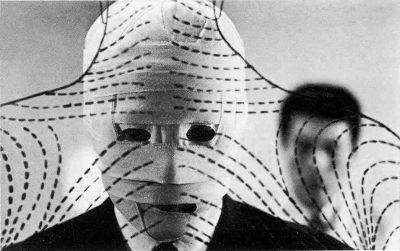
Tatsuya Nakadai searches for identity in THE FACE OF ANOTHER
THE FACE OF ANOTHER (Hiroshi Teshigahara, 1966)
Film Forum
209 West Houston St.
Tuesday, December 7, 1:00, 3:30, 8:35
Series continues through December 16
212-727-8110
www.filmforum.org
 Japanese novelist Kôbô Abe and director Hiroshi Teshigahara collaborated on five films together, including the marvelously existential WOMAN OF THE DUNES in 1964 and THE FACE OF ANOTHER two years later. In THE FACE OF ANOTHER, Tatsuya Nakadai (THE HUMAN CONDITION, KILL!) stars as Okuyama, a man whose face has virtually disintegrated in a laboratory accident. He spends the first part of the film with his head wrapped in bandages, a la the Invisible Man, as he talks about identity, self-worth, and monsters with his wife (Machiko Kyo), who seems to be growing more and more disinterested in him. Then Okuyama visits a psychiatrist (Mikijirô Hira) who is able to create a new face for him, one that would allow him to go out in public and just become part of the madding crowd again. But his doctor begins to wonder, as does Okuyama, whether the mask has actually taken control of his life, making him as helpless as he was before. Abe’s remarkable novel is one long letter from Okuyama to his wife, filled with utterly brilliant, spectacularly detailed examinations of what defines a person and his or her value in society. Abe wrote the film’s screenplay, which tinkers with the time line and creates more situations in which Okuyama interacts with people; although that makes sense cinematically, much of Okuyama’s interior narrative, the building turmoil inside him, gets lost. Teshigahara once again uses black and white, incorporating odd cuts, zooms, and freeze frames, amid some truly groovy sets, particularly the doctor’s trippy office, and Tōru Takemitsu’s score is ominously groovy as well. As a counterpart to Okuyama, the film also follows a young woman (Miki Irie) with one side of her face severely scarred; she covers it with her hair and is not afraid to be seen in public, while Okuyama must hide behind a mask. But as Abe points out in both the book and the film, everyone hides behind a mask of one kind or another.
Japanese novelist Kôbô Abe and director Hiroshi Teshigahara collaborated on five films together, including the marvelously existential WOMAN OF THE DUNES in 1964 and THE FACE OF ANOTHER two years later. In THE FACE OF ANOTHER, Tatsuya Nakadai (THE HUMAN CONDITION, KILL!) stars as Okuyama, a man whose face has virtually disintegrated in a laboratory accident. He spends the first part of the film with his head wrapped in bandages, a la the Invisible Man, as he talks about identity, self-worth, and monsters with his wife (Machiko Kyo), who seems to be growing more and more disinterested in him. Then Okuyama visits a psychiatrist (Mikijirô Hira) who is able to create a new face for him, one that would allow him to go out in public and just become part of the madding crowd again. But his doctor begins to wonder, as does Okuyama, whether the mask has actually taken control of his life, making him as helpless as he was before. Abe’s remarkable novel is one long letter from Okuyama to his wife, filled with utterly brilliant, spectacularly detailed examinations of what defines a person and his or her value in society. Abe wrote the film’s screenplay, which tinkers with the time line and creates more situations in which Okuyama interacts with people; although that makes sense cinematically, much of Okuyama’s interior narrative, the building turmoil inside him, gets lost. Teshigahara once again uses black and white, incorporating odd cuts, zooms, and freeze frames, amid some truly groovy sets, particularly the doctor’s trippy office, and Tōru Takemitsu’s score is ominously groovy as well. As a counterpart to Okuyama, the film also follows a young woman (Miki Irie) with one side of her face severely scarred; she covers it with her hair and is not afraid to be seen in public, while Okuyama must hide behind a mask. But as Abe points out in both the book and the film, everyone hides behind a mask of one kind or another.
THE FACE OF ANOTHER is screening as part of Film Forum’s two-week salute to composer Tōru Takemitsu (1930-96), who scored THE FACE OF ANOTHER and more than one hundred other films, including such diverse works as Teshigahara’s ANTONIO GAUDI, PITFALL, and WOMAN IN THE DUNES, Nagisa Oshima’s THE CEREMONY, Masahiro Shinoda’s CHINMOKU and PALE FLOWER, Mitsuo Yanagimachi’s HIMATSURI, Kon Ichikawa’s ALONE ON THE PACIFIC, Masaki Kobayashi’s KWAIDAN, YOUTH OF JAPAN, HARAKIRI, and SAMURAI REBELLION, and Akira Kurosawa’s RAN and DODES’KA-DEN, all of which are part of the series. The music of Takemitsu will also be celebrated this month at the JapanNYC Festival, with Seiji Ozawa conducting the Saito Kinen Orchestra in a presentation of Takemitsu’s “November Steps,” with Yukio Tanaka on biwa and Kifu Mitsuhashi on shakuhachi, at Carnegie Hall on December 15 (in addition to Berlioz’s Symphonie fantastique), a concert featuring traditional hōgaku instruments at the Institute for Medieval Japanese Studies at Columbia University on December 16, and a tribute concert at Zankel Hall on December 17 curated by his daughter, Maki Takemitsu, with jazz performances of his film scores performed by guitarists Kazumi Watanabe and Daisuke Suzuki, accordionist coba, and percussionist Tomohiro Yahiro.
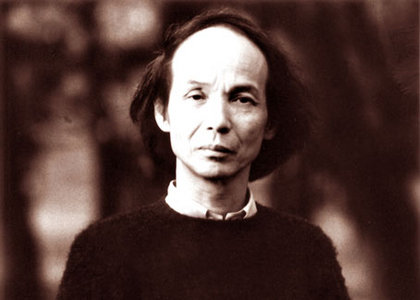
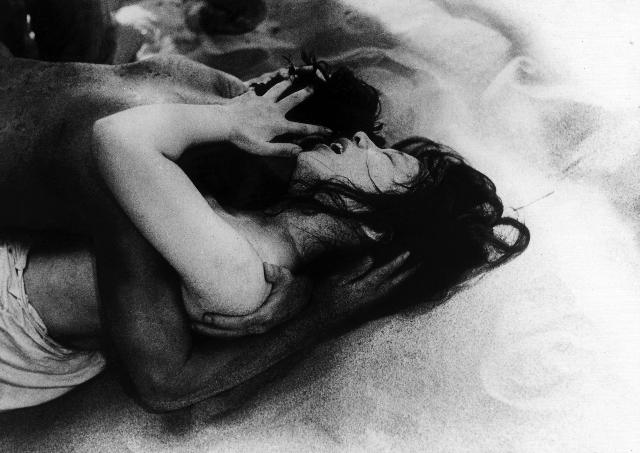
 Hiroshi Teshigahara’s Sisyphean tale, based on Kobo Abe’s marvelous novel, tells the story of an entomologist (Eiji Okada) out in the desert looking for insects when he comes upon a village of people living in the sand dunes — and he is unknowingly sucked into their world. Kyōko Kishida stars as the title character. See the movie — just wait till you get to the psychedelic head trip scene — but be sure to read the book as well; the scenes of the man trying to escape by climbing up the sand will feel oddly familiar to anyone who has ever been trapped in a seemingly inescapable situation. Teshigahara, who died in April 2001, adds surreal visual elements that make the film an unusually compelling though basically simple story. Abe also collaborated with Teshigahara on PITFALL (OTOSHIANA), THE FACE OF ANOTHER (TANIN NO KAO), and THE MAN WITHOUT A MAP (MOETSUKITA CHIZU).
Hiroshi Teshigahara’s Sisyphean tale, based on Kobo Abe’s marvelous novel, tells the story of an entomologist (Eiji Okada) out in the desert looking for insects when he comes upon a village of people living in the sand dunes — and he is unknowingly sucked into their world. Kyōko Kishida stars as the title character. See the movie — just wait till you get to the psychedelic head trip scene — but be sure to read the book as well; the scenes of the man trying to escape by climbing up the sand will feel oddly familiar to anyone who has ever been trapped in a seemingly inescapable situation. Teshigahara, who died in April 2001, adds surreal visual elements that make the film an unusually compelling though basically simple story. Abe also collaborated with Teshigahara on PITFALL (OTOSHIANA), THE FACE OF ANOTHER (TANIN NO KAO), and THE MAN WITHOUT A MAP (MOETSUKITA CHIZU).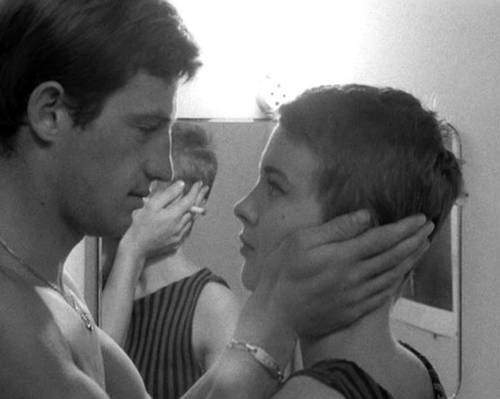
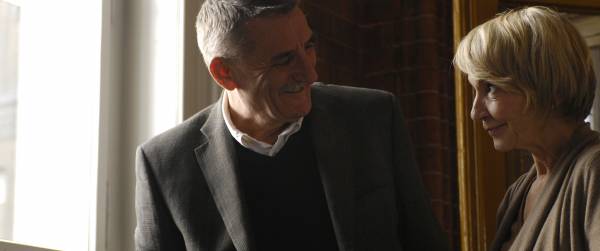
 Inspired by the success of THE LIVES OF OTHERS, Florian Henckel von Donnersmarck’s Oscar-winning 2006 drama about the German secret police, the Czech team of writer Petr Jarchovsky and director Jan Hrebejk (DIVIDED WE FALL, BEAUTY IN TROUBLE) tackle a similar subject from a different point of view in the powerful KAWASAKI’S ROSE. After discovering that her mystery illness is not terminal cancer, Lucie (Lenka Vlasáková) returns home to her husband, Ludek (Milan Mikulcik), and daughter, Bara (Anna Simonová), only to find out that Ludek is once again seeing his former lover, Radka (Petra Hrebícková). Ludek and Radka are working on a documentary about Lucie’s father, Pavel (Martin Huba), who is about to receive the coveted Czech memory prize in honor of his work with disabled children since the Velvet Revolution. But when Lucie understandably refuses to accept Radka’s gesture of friendship, Ludek decides to get even after being given Pavel’s complete dossier, which reveals that the beloved doctor and his wife, Jana (Daniela Kolárová), have been keeping some very damaging secrets that could tear apart their family. Like THE LIVES OF OTHERS, KAWASAKI’S ROSE is a nearly flawless film, with well-drawn characters, a compelling, emotional story, and a gripping narrative structure, always offering something unexpected. The performances are uniformly excellent, the script subtle and intelligent. Curiously, the only misstep, and thankfully it’s just a minor tangent, involves the title figure, Mr. Kawasaki (Isao Onoda), a painter who was taken in by Jana’s onetime lover, anarchist sculptor Borek (Antonin Kratochvil). Kawasaki seems completely unnecessary, existing merely as a metaphor both within the film and outside it, referring to master mathematician and paper folder Toshikazu Kawasaki and his famed origami rose that flows out from the center. Hrebejk will be at Film Forum for the 7:50 show on November 27.
Inspired by the success of THE LIVES OF OTHERS, Florian Henckel von Donnersmarck’s Oscar-winning 2006 drama about the German secret police, the Czech team of writer Petr Jarchovsky and director Jan Hrebejk (DIVIDED WE FALL, BEAUTY IN TROUBLE) tackle a similar subject from a different point of view in the powerful KAWASAKI’S ROSE. After discovering that her mystery illness is not terminal cancer, Lucie (Lenka Vlasáková) returns home to her husband, Ludek (Milan Mikulcik), and daughter, Bara (Anna Simonová), only to find out that Ludek is once again seeing his former lover, Radka (Petra Hrebícková). Ludek and Radka are working on a documentary about Lucie’s father, Pavel (Martin Huba), who is about to receive the coveted Czech memory prize in honor of his work with disabled children since the Velvet Revolution. But when Lucie understandably refuses to accept Radka’s gesture of friendship, Ludek decides to get even after being given Pavel’s complete dossier, which reveals that the beloved doctor and his wife, Jana (Daniela Kolárová), have been keeping some very damaging secrets that could tear apart their family. Like THE LIVES OF OTHERS, KAWASAKI’S ROSE is a nearly flawless film, with well-drawn characters, a compelling, emotional story, and a gripping narrative structure, always offering something unexpected. The performances are uniformly excellent, the script subtle and intelligent. Curiously, the only misstep, and thankfully it’s just a minor tangent, involves the title figure, Mr. Kawasaki (Isao Onoda), a painter who was taken in by Jana’s onetime lover, anarchist sculptor Borek (Antonin Kratochvil). Kawasaki seems completely unnecessary, existing merely as a metaphor both within the film and outside it, referring to master mathematician and paper folder Toshikazu Kawasaki and his famed origami rose that flows out from the center. Hrebejk will be at Film Forum for the 7:50 show on November 27.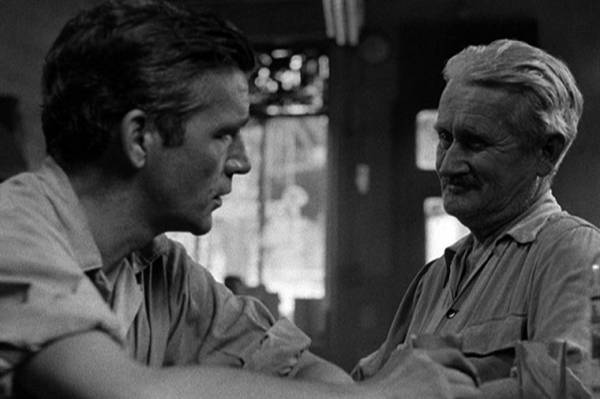
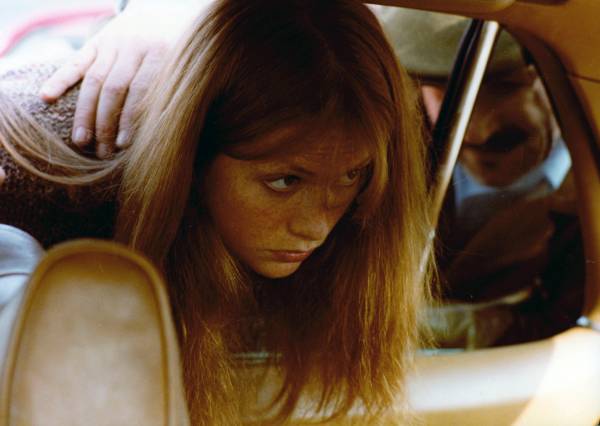
 Screening at Film Forum in a new 35mm print in honor of its thirtieth anniversary, Jean-Luc Godard’s EVERY MAN FOR HIMSELF marked a return to a somewhat more accessible narrative for the Nouvelle Vague auteur, although that does not mean it is by any means a traditional story or that it follows mainstream conventions. Arranged in four sections — the Imaginary (Slow Motion), Fear (Run for Your Life), Commerce (Trade), and Music — the film focuses on a smarmy, unlikable cigar-smoking video director, unironically named Paul Godard (Jacques Dutronc), who fights with his ex-wife (Paule Muret), wonders why he can’t touch his eleven-year-old daughter (Cécile Tanner) in rather sensitive areas, has driven away his bicycle-riding girlfriend, Denise Rimbaud (Nathalie Baye), and pays for a visit from Isabelle (Isabelle Huppert), a prostitute who recites lines from Charles Bukowski in her head while plying her trade and seeking her independence. Godard frames many of the images like paintings, coming alive with bright, bold colors. Nearly all of the interior scenes are filmed in long takes with no camera movement or cross-cutting (with two notable exceptions), while other scenes are filled with slow-motion shots, forcing viewers to question what they are seeing. Meanwhile, snippets of Gabriel Yared’s score and incidental music are often heard by only some of the characters, who wonder where the sounds are coming from. Godard infuses the film with various thoughts on Marxism, feminism, capitalism, pedophilia, incest, and violence against women; in one unforgettable scene, a businessman arranges a ridiculously funny Rube Goldberg-like foursome, acting like a film director, mocking Jean-Luc Godard’s own profession. Thirty years down the road, EVERY MAN FOR HIMSELF, also known as SLOW MOTION and, in French, SAUVE QUI PEUT (LA VIE), feels as relevant, as challenging, and as entertaining as ever. (Note: Film critic and Godard biographer Richard Brody will introduce the 8:20 screening on November 19.)
Screening at Film Forum in a new 35mm print in honor of its thirtieth anniversary, Jean-Luc Godard’s EVERY MAN FOR HIMSELF marked a return to a somewhat more accessible narrative for the Nouvelle Vague auteur, although that does not mean it is by any means a traditional story or that it follows mainstream conventions. Arranged in four sections — the Imaginary (Slow Motion), Fear (Run for Your Life), Commerce (Trade), and Music — the film focuses on a smarmy, unlikable cigar-smoking video director, unironically named Paul Godard (Jacques Dutronc), who fights with his ex-wife (Paule Muret), wonders why he can’t touch his eleven-year-old daughter (Cécile Tanner) in rather sensitive areas, has driven away his bicycle-riding girlfriend, Denise Rimbaud (Nathalie Baye), and pays for a visit from Isabelle (Isabelle Huppert), a prostitute who recites lines from Charles Bukowski in her head while plying her trade and seeking her independence. Godard frames many of the images like paintings, coming alive with bright, bold colors. Nearly all of the interior scenes are filmed in long takes with no camera movement or cross-cutting (with two notable exceptions), while other scenes are filled with slow-motion shots, forcing viewers to question what they are seeing. Meanwhile, snippets of Gabriel Yared’s score and incidental music are often heard by only some of the characters, who wonder where the sounds are coming from. Godard infuses the film with various thoughts on Marxism, feminism, capitalism, pedophilia, incest, and violence against women; in one unforgettable scene, a businessman arranges a ridiculously funny Rube Goldberg-like foursome, acting like a film director, mocking Jean-Luc Godard’s own profession. Thirty years down the road, EVERY MAN FOR HIMSELF, also known as SLOW MOTION and, in French, SAUVE QUI PEUT (LA VIE), feels as relevant, as challenging, and as entertaining as ever. (Note: Film critic and Godard biographer Richard Brody will introduce the 8:20 screening on November 19.)